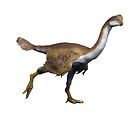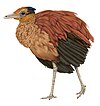近鳥龍科
| 近鳥龍科 | |
|---|---|

| |
| 赫氏近鳥龍骨骼重建 | |
| 科學分類 | |
| 界: | 動物界 Animalia |
| 門: | 脊索動物門 Chordata |
| 綱: | 蜥形綱 Sauropsida |
| 總目: | 恐龍總目 Dinosauria |
| 目: | 蜥臀目 Saurischia |
| 亞目: | 獸腳亞目 Theropoda |
| 演化支: | 鳥翼類 Avialae |
| 科: | †近鳥龍科 Anchiornithidae Xu et al. 2016 sensu Foth & Rauhut, 2017 |
| 模式種 | |
| †赫氏近鳥龍 Anchiornis huxleyi Xu et al., 2009
| |
| 屬 | |
| 異名 | |
| |
近鳥龍科(學名:Anchiornithidae,意為「接近鳥類」)是真手盜龍類的一個科,可能是演化支鳥翼類中鳥類最基礎的一科(一般意義上)。[1]該科被置於真手盜龍類演化樹中的不同位置,一些科學家曾將其分類為一個不同的科、傷齒龍科的一個基礎亞科、[2][3][4][5]始祖鳥科成員[2][6]以及鳥翼類[7]或近鳥類[8]中屬於進化等級的恐龍組合。
描述
[編輯]近鳥龍科與其它近鳥類和早期鳥翼類具有許多共同特徵。它們是輕巧的小型有羽毛食肉動物,在生物學上類似始祖鳥、早期馳龍科(如小盜龍),特別是傷齒龍科。它們幾乎唯一所知於中國的晚侏羅世沉積物,儘管奧斯特倫姆龍是在德國發現的,並且據信義縣龍(該分類群一個僅所知於前肢的推測成員)生存於白堊紀早期。大多數近鳥龍科的腿、前肢和手都很長,儘管部分物種的前肢略微縮短(如始中國羽龍)。[9]
羽毛
[編輯]
儘管實際上可以確定每種近鳥龍科都具有先進的正羽,但是不同屬之間的羽毛仍然存在很多差異。多數物種的尾羽呈葉片狀,形成葉狀尾巴,其中彩虹龍的尾羽特別長且不對稱。[10]但是始中國羽龍、絲鳥龍和曙光鳥保留了短而柔軟的尾羽。對該科物種羽毛的一些研究表明其羽毛呈羽狀,但似乎缺乏羽小枝,使它們在動物生前「蓬鬆」或「柔軟」。[11][8]
大多數近鳥龍科的手臂上都長有較長的正羽。但是這些羽毛纖細、對稱且不特化,可能對飛行毫無用處,它們連成一排並直接附屬於連接上臂和下臂的大型肉質前膜。[12][8]
大多數近鳥龍科的腿部下方還長有密集的羽毛,少數物種的腿羽較短,但大多數(如近鳥龍和足羽龍)具有很長的正羽,給了它們「四翼恐龍」的綽號――這也是小盜龍類的共同特徵。始祖鳥腿部下端似乎沒有任何羽毛,但其近親絲鳥龍擁有既延伸至腳趾的絨毛,又具有延伸至腿上的正羽。[9][8]
鑑別特徵
[編輯]福斯和勞赫確立了該科的幾個鑑別特徵:[1]
- 齒骨的滋養孔位於一個深溝中(同樣見於大多數傷齒龍科和其它虛骨龍類);
- 前牙比齒列中間的牙齒更小、數量更多、間距更近(同樣見於大多數傷齒龍科);
- 肩胛骨的肩峰緣(acromion margin)前嵴向外彎曲(同樣見於一些竊蛋龍科和更多衍生鳥翼類);
- 腓骨近端內表面扁平(同樣見於阿瓦拉慈龍類、鐮刀龍類和衍生鳥翼類);
- 扇形的後背神經棘(同樣見於美頜龍科和一些衍生鳥翼類);
- 腳和腳踝上廣泛的大型正羽(同樣見於小盜龍和會鳥)。
分類歷史
[編輯]查特吉於2015年在其著作《鳥類崛起:2.25億年的進化》(The Rise of Birds: 225 Million Years of Evolution)第二版中創建四翼鳥科(Tetrapterygidae),其中包含曉廷龍、曙光鳥、近鳥龍甚至小盜龍,四者均被提出是鳥翼類演化支的姐妹群。[13]然而該科有效的前提是必須包括四翼鳥屬(Tetrapteryx)——現為鶴屬的次異名,因此四翼鳥科是鶴科的次異名。[14]
在對維恩獵龍的描述中,勞赫等人稱該分類辭為「近鳥龍類」("Anchiornithosaurs")並置於鳥翼類以外。[15]
該演化支最初由徐星等人(2016年)命名為「近鳥龍亞科」("Anchiornithinae")並定義為「包括近鳥龍但不包括始祖鳥、原雞、傷齒龍、馳龍、半鳥或耀龍的最大演化支」。[16]
2017年,福斯與勞赫在對始祖鳥哈勒姆標本(作者將其分類為不同屬奧斯特倫姆龍[1])的重新研究中發現近鳥龍科是種與鳥類祖先近緣的不同科。[1]他們提出了自己對近鳥龍科的定義即「與赫氏近鳥龍的親緣關係近於家麻雀、印石板始祖鳥、艾伯塔馳龍、美麗傷齒龍及嗜角偷蛋龍的所有手盜龍類」。[1]
考爾等人(2017年)在哈茲卡盜龍的描述中將許多假定的近鳥龍科納入兩個不同的大規模系統發育分析。第一項是對獸腳類恐龍的全面研究,最初由李等人為2014年一篇關於獸腳類小型化導致鳥類進化的論文設計。考爾等人對第一次分析的使用支持近鳥龍科是鳥翼類的一個不同科。第一次分析的嚴格一致性樹如下所示:[17]
| 鳥翼類 Avialae |
| ||||||||||||||||||||||||||||||||||||||||||||||||||||||||||||||||||
第二次分析首次使用布魯薩特等人2014年發表的另一篇關於獸腳類體型的論文。這項分析(於考爾等人2015年對邦多克巴拉烏爾龍親緣關係的研究中進行了更新[18])集中在腔骨龍類上,並發現與第一次分析相比,近鳥龍科(分析中僅以近鳥龍、曉廷龍、曙光鳥和始中國羽龍為代表)均為傷齒龍科而非鳥翼類。[17]
徐星等人(2018年)對彩虹龍的描述中也進行了布魯薩特的分析並發現相同結果。然而,該研究也進行了徐星等人(2015年)描述奇翼龍時所作的分析。該分析要麼將近鳥龍科(研究中稱為「近鳥龍亞科」成員)置於傷齒龍科,要麼列為未解決的近鳥類,取決於使用簡約分析還是自舉分析。[19]
勞赫等人(2019年)對侏羅紀鳥類阿爾特米爾鳥的描述中使用的分析將近鳥龍科(此分析中以始中國羽龍、近鳥龍及奧斯特倫姆龍為代表)最原始的鳥翼類。曉廷龍和足羽龍則視為與始祖鳥近緣的更衍生鳥翼類。[20]
2019年,哈特曼在晚侏羅世鳥類似黃昏鳥的描述中使用了每種已命名中生代手盜龍形態類(加上28件未命名標本),他們對這些標本進行了700個字符和501個操作分類單元的評估,發現大多數近鳥龍科均為始祖鳥科成員,唯有曉廷龍和義縣龍被分別歸入傷齒龍科及馳龍科,足羽龍在近鳥類系統發育中彼恢復為許多疑似位置上,奧斯特倫姆龍則因描述時間太晚而無法納入分析。[6]分支圖如下:
| 始祖鳥科 Archaeopterygidae |
| ||||||||||||||||||||||||||||||
以下分支圖展示了考爾(2020年)的系統發育分析結果。[21]
| |||||||||||||||||||||||||||||||||||||||||||||||||
古生態學
[編輯]從中國遼寧省距今1.6億年的髫髻山組中發現了絕大多數已知近鳥龍科。[22][23]從髫髻山組存在的植物來看,該時期的氣候表現為溫暖潮濕的亞熱帶至溫帶氣候。[24]該環境中裸子植物佔主導地位,包括銀杏科的似銀杏屬、銀杏屬和裂銀杏屬;茨康目的茨康葉屬和擬刺葵屬;松柏門的松型葉屬、扇杉屬、樅型枝屬、裂鱗果屬和蘇鐵杉屬;石松綱的擬石松屬和似卷柏屬、木賊亞綱的木賊屬;蘇鐵目的異羽葉屬;真蕨類的似托第蕨屬和錐葉蕨屬[25]。不是在髫髻山組發現的中國近鳥龍科,包括同區域距今1.25億年早白堊世義縣組發現的長掌義縣龍以及福建省距今1.5億年晚侏羅世南園組發現的奇異福建龍。[26]該科唯一一個在中國以外發現的屬是奧斯特倫姆龍,發現於德國巴伐利亞里登堡的派恩滕組。[1]
參考資料
[編輯]- ^ 1.0 1.1 1.2 1.3 1.4 1.5 Foth, C.; Rauhut, O. W. M. Re-evaluation of the Haarlem Archaeopteryx and the radiation of maniraptoran theropod dinosaurs. BMC Evolutionary Biology. 2017, 17 (1): 236. PMC 5712154
 . PMID 29197327. doi:10.1186/s12862-017-1076-y.
. PMID 29197327. doi:10.1186/s12862-017-1076-y.
- ^ 2.0 2.1 Xing Xu; Hailu You; Kai Du & Fenglu Han. An Archaeopteryx-like theropod from China and the origin of Avialae (PDF). Nature. 2011-07-28, 475 (7357): 465–470 [2017-12-06]. PMID 21796204. doi:10.1038/nature10288. (原始內容 (PDF)存檔於2016-12-20).
- ^ Lee, M. S. Y. & Worthy, T. H. Likelihood reinstates Archaeopteryx as a primitive bird. Biology Letters. 2011, 8 (2): 299–303. PMC 3297401
 . PMID 22031726. doi:10.1098/rsbl.2011.0884.
. PMID 22031726. doi:10.1098/rsbl.2011.0884.
- ^ Stephen L. Brusatte; Graeme T. Lloyd; Steve C. Wang; Mark A. Norell. Gradual assembly of avian body plan culminated in rapid rates of evolution across the dinosaur-bird transition. Current Biology. 2014, 24 (20): 2386–2392. PMID 25264248. doi:10.1016/j.cub.2014.08.034.
- ^ Cai-zhi Shen; Bo Zhao; Chun-ling Gao; Jun-chang Lü; Martin Kundrát. A New Troodontid Dinosaur (Liaoningvenator curriei gen. et sp. nov.) from the Early Cretaceous Yixian Formation in Western Liaoning Province. Acta Geoscientica Sinica. 2017, 38 (3): 359–371. doi:10.3975/cagsb.2017.03.06.
- ^ 6.0 6.1 Hartman, Scott; Mortimer, Mickey; Wahl, William R.; Lomax, Dean R.; Lippincott, Jessica; Lovelace, David M. A new paravian dinosaur from the Late Jurassic of North America supports a late acquisition of avian flight. PeerJ. 2019, 7: e7247. PMC 6626525
 . PMID 31333906. doi:10.7717/peerj.7247.
. PMID 31333906. doi:10.7717/peerj.7247.
- ^ Wang, M.; Wang, X.; Wang, Y.; Zhou, Z. A new basal bird from China with implications for morphological diversity in early birds. Scientific Reports. 2016, 6: 19700. PMC 4726217
 . PMID 26806355. doi:10.1038/srep19700.
. PMID 26806355. doi:10.1038/srep19700.
- ^ 8.0 8.1 8.2 8.3 Lefèvre, Ulysse; Cau, Andrea; Cincotta, Aude; Hu, Dongyu; Chinsamy, Anusuya; Escuillié, François; Godefroit, Pascal. A new Jurassic theropod from China documents a transitional step in the macrostructure of feathers. The Science of Nature. 2017, 104 (9–10): 74. Bibcode:2017SciNa.104...74L. PMID 28831510. doi:10.1007/s00114-017-1496-y.
- ^ 9.0 9.1 Godefroit, Pascal; Demuynck, Helena; Dyke, Gareth; Hu, Dongyu; Escuillié, François; Claeys, Philippe. Reduced plumage and flight ability of a new Jurassic paravian theropod from China. Nature Communications. 2013-01-22, 4: 1394. PMID 23340434. doi:10.1038/ncomms2389 (英語).
- ^ Dongyu Hu; Julia A. Clarke; Chad M. Eliason; Rui Qiu; Quanguo Li; Matthew D. Shawkey; Cuilin Zhao; Liliana D'Alba; Jinkai Jiang; Xing Xu. A bony-crested Jurassic dinosaur with evidence of iridescent plumage highlights complexity in early paravian evolution. Nature Communications. 2018, 9 (1): Article number 217. Bibcode:2018NatCo...9..217H. PMC 5768872
 . PMID 29335537. doi:10.1038/s41467-017-02515-y.
. PMID 29335537. doi:10.1038/s41467-017-02515-y.
- ^ Saitta, Evan T.; Gelernter, Rebecca; Vinther, Jakob. Additional information on the primitive contour and wing feathering of paravian dinosaurs. Palaeontology. 2018, 61 (2): 273–288. ISSN 1475-4983. doi:10.1111/pala.12342. hdl:1983/61351c6d-1517-4101-bac8-50cbb733761d (英語).
- ^ Wang, Xiaoli; Pittman, Michael; Zheng, Xiaoting; Kaye, Thomas G.; Falk, Amanda R.; Hartman, Scott A.; Xu, Xing. Basal paravian functional anatomy illuminated by high-detail body outline. Nature Communications. 2017-03-01, 8: 14576. Bibcode:2017NatCo...814576W. PMC 5339877
 . PMID 28248287. doi:10.1038/ncomms14576 (英語).
. PMID 28248287. doi:10.1038/ncomms14576 (英語).
- ^ Chatterjee, S. The rise of birds: 225 million years of evolution. Johns Hopkins University Press. 2015: 45–48.
- ^ Matthew Martyniuk. The Crane and the Microraptor. DinoGoss: A blog about stem-birds. May 24, 2015. (原始內容存檔於16 June 2015).
- ^ Rauhut, O.W.M.; Hübner, T.R.; Lanser, K. A new theropod dinosaur from the late Middle Jurassic of Germany and theropod faunal turnover during the Jurassic. Libro de resúmenes del V Congreso Latinoamericano de Paleontología de Vertebrados. 2015, 62.
- ^ Xu; et al. An Updated Review of the Middle-Late Jurassic Yanliao Biota: Chronology, Taphonomy, Paleontology and Paleoecology. Acta Geologica Sinica. 2016, 90 (6): 2229–2243. doi:10.1111/1755-6724.13033.
- ^ 17.0 17.1 Cau, A.; Beyrand, V.; Voeten, D.; Fernandez, V.; Tafforeau, P.; Stein, K.; Barsbold, R.; Tsogtbaatar, K.; Currie, P.; Godefroit, P. Synchrotron scanning reveals amphibious ecomorphology in a new clade of bird-like dinosaurs. Nature. 2017, 552 (7685): 395–399. Bibcode:2017Natur.552..395C. PMID 29211712. doi:10.1038/nature24679.
- ^ Cau, Andrea; Brougham, Tom; Naish, Darren. The phylogenetic affinities of the bizarre Late Cretaceous Romanian theropodBalaur bondoc(Dinosauria, Maniraptora): dromaeosaurid or flightless bird?. PeerJ. 2015-06-18, 3: e1032. ISSN 2167-8359. PMC 4476167
 . PMID 26157616. doi:10.7717/peerj.1032 (英語).
. PMID 26157616. doi:10.7717/peerj.1032 (英語).
- ^ Xu, Xing; Jiang, Jinkai; D'Alba, Liliana; Zhao, Cuilin; Matthew D. Shawkey; Li, Quanguo; Qiu, Rui; Eliason, Chad M.; Clarke, Julia A. A bony-crested Jurassic dinosaur with evidence of iridescent plumage highlights complexity in early paravian evolution. Nature Communications. 2018-01-15, 9 (1): 217. Bibcode:2018NatCo...9..217H. ISSN 2041-1723. PMC 5768872
 . PMID 29335537. doi:10.1038/s41467-017-02515-y (英語).
. PMID 29335537. doi:10.1038/s41467-017-02515-y (英語).
- ^ Rauhut, O.; Tischlinger, H.; Foth, C. A non-archaeopterygid avialan theropod from the Late Jurassic of southern Germany. eLife. 2019-05-14, 8: e43789. ISSN 2050-084X. PMC 6516837
 . PMID 31084702. doi:10.7554/eLife.43789.
. PMID 31084702. doi:10.7554/eLife.43789.
- ^ Cau, Andrea. The body plan of Halszkaraptor escuilliei (Dinosauria, Theropoda) is not a transitional form along the evolution of dromaeosaurid hypercarnivory. PeerJ. 2020-02-25, 8: e8672 [2023-09-11]. ISSN 2167-8359. PMC 7047864
 . PMID 32140312. doi:10.7717/peerj.8672. (原始內容存檔於2021-08-07) (英語).
. PMID 32140312. doi:10.7717/peerj.8672. (原始內容存檔於2021-08-07) (英語).
- ^ Zhou, Z.-H.; Wang, Y. Vertebrate assemblages of the Jurassic Yanliao Biota and the Early Cretaceous Jehol Biota: Comparisons and implications. Paleoworld. 2017, 26 (2): 241. doi:10.1016/j.palwor.2017.01.002.
- ^ Sullivan, C.; Wang, Y.; Hone, D.W.E.; Wang, Y.; Xu, X.; Zhang, F. The vertebrates of the Jurassic Daohugou Biota of northeastern China. Journal of Vertebrate Paleontology. 2014, 34 (2): 243–280. doi:10.1080/02724634.2013.787316.
- ^ Wang, Y.; Ken, S.; Zhang, W.; Zheng, S. Biodiversity and palaeoclimate of the Middle Jurassic floras from the Tiaojishan Formation in western Liaoning, China. Progress in Natural Science. 2006, 16 (1): 222–230. doi:10.1080/10020070612330087.
- ^ Zhang, Kuiyan; Yang, Ding; Ren, Dong. The first snipe fly (Diptera: Rhagionidae) from the Middle Jurassic of Inner Mongolia, China. Zootaxa. 2006, 1134: 51–57. doi:10.11646/zootaxa.1134.1.3.
- ^ Xu, L.; Wang, M.; Chen, R.; Dong, L.; Lin, M.; Xu, X.; Tang, J.; You, H.; Zhou, G.; Wang, L.; He, W.; Li, Y.; Zhang, C.; Zhou, Z. A new avialan theropod from an emerging Jurassic terrestrial fauna. Nature. 2023,. in press. ISSN 1476-4687. doi:10.1038/s41586-023-06513-7
 (英語).
(英語).























